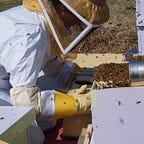Can Using Artificial Intelligence Bridge the Gap for Beekeepers?
As reports continue to pour in over the concerning decline of bee populations worldwide, it is no surprise that artificial intelligence (AI) program designers have come up with a solution that may help beekeepers bridge the gap in their craft. Passionate and diligent beekeepers may never consider using AI for their hives. Still, it is proving to be a helpful tool for many motivated people to provide the best care and keep the closest pulse on their beehive activity. What AI offers is continual monitoring of hive activity and bee health. Monitoring temperature, water, and food availability takes some of the guesswork out of beekeeping. Still, some beekeepers argue that figuring it out is a significant part of what makes beekeeping so rewarding.
24-Hour Beehive Surveillance
While most beekeepers sleep, AI never stops monitoring a beehive’s health. AI never stops working, providing continuous tracking 24 hours a day, 365 days a year. The various programs that are now coming out to aid in beekeeping also monitor activity and behavior within the hive, giving beekeepers an advantage in identifying times when a beehive may need tending that they may miss otherwise. Some of the more recent AI programs are able to detect when bees bring pollen back to the beehive, which is a huge tell on beehive health. Those supporting AI in beekeeping believe that the collected data provides information helpful in planting in the bee’s flight [path and within reasonable distance to the hive. If beekeepers are able to see what bees are collecting, they can provide more food sources within that distance range. Bee species vary in the distance they are willing to go for water and food, so this knowledge may prove very helpful to beekeepers to ensure their beehives have what they need.
AI Monitoring Temperature Shifts in Beehives
Beekeepers know that shifts in temperatures within the hive indicate something happening within the beehive. Even this summer, when temperatures were extremely hot and lasted longer than usual, some beekeepers were not able to save their hives because the temperature shift was too harmful. A beehive’s temperature directly relates to its health. Extreme cold or hot temperatures can adversely affect a beehive’s health. If a hive becomes hot, it may indicate bees are defending their hive from an intruder, and beekeepers would benefit from knowing the beehive is under attack from a wasp or hornet. Temperature shifts will also occur if a beehive is being infested with mites or another disease, so knowing temperature shifts earlier may give beekeepers an advantage when treating their hives.
Using Collected Data from Beehives to Influence Decision Makers
Some claim that using AI and collecting hard data may be beneficial when pleading with law and decision-makers to make big changes to help declining bee populations. Supporters of collecting beehive activity through data collection believe that without hard data, change is impossible. Decisions and laws related to the environment should include the protection of critical pollinators like bees. Land development is a well-known culprit of declining bee populations due to less open green spaces. It is hoped that AI collecting beehive data can be used to influence law and decision makers in the future.
Shedding Light on Beehive Health and Making Changes
Whether you agree or disagree with using AI to help in the beekeeping process, the benefits are undeniable. It is likely commercial beekeepers will be some of the pioneers due to cost and a desire to monitor big beehive numbers. Small beekeepers may not feel it is necessary to have AI monitoring their hives because they spend enough time observing their beehives themselves. However, the attention that AI is bringing to the essential need to take care of our bees is a win-win for everyone. Regardless of who uses AI first in their beekeeping, the collected data will ideally be shared and ultimately create a path for change to help bees survive and thrive.
The nuances of beekeeping, between equipment, number of beehives, and experience, inevitably result in different views on beekeeping and best practices. The good news for all of us is that beekeepers are all interested in helping bees, and even if the road to get there is different, the goal is the same — to provide protection and resources for bee colonies. If you never have, connect with a local beekeeper, and you may find your passion to help these essential pollinator populations grow and stay healthy! No one person can make all the changes, but together, we can change the future for the bees!
